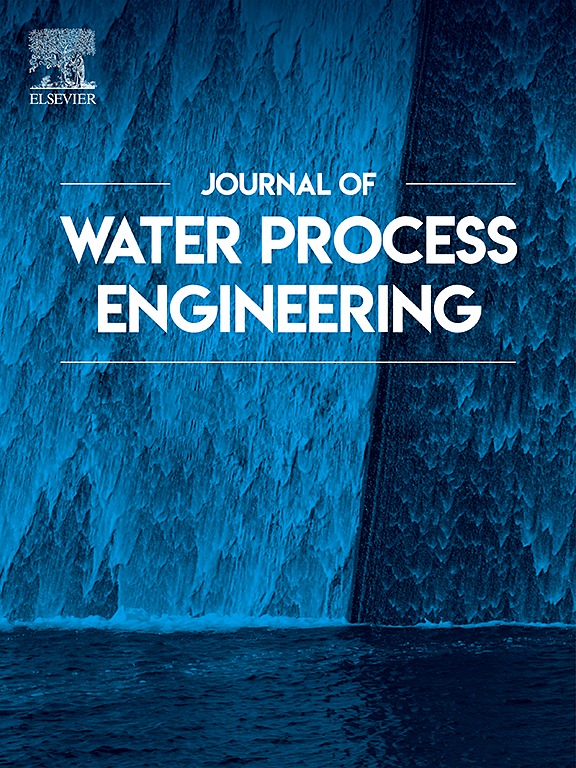ZIF-90@floating微球的仿生催化加速了脂质降解中的界面反应
IF 6.3
2区 工程技术
Q1 ENGINEERING, CHEMICAL
引用次数: 0
摘要
石油污染及其治理的全球性挑战需要创新的解决方案。脂肪酶是一种高效、环保的石油降解方法。然而,脂肪酶仅在油水界面处具有活性,其有效性受到稳定性差和失活的阻碍。本研究介绍了ZIF-90作为传统脂肪酶的替代品。它能够激活H2O生成•OH和•H自由基来水解脂质,从而显示出与脂肪酶相当的酶活性。漂浮微球的开发是为了解决脂肪酶稳定性和界面激活的局限性。它们是通过3D打印含有ZIF-90的低密度空心微球制成的,确保了在反应过程中所有ZIF-90在油水界面的最佳位置。这使得微球内的ZIF-90能够在界面处与油底物和水分子充分相互作用,有效催化石油污染降解,而无需在大面积水域搅拌和乳化。这种创新方法的催化活性比游离酶高6.61倍。值得注意的是,强酸或高温处理促进了ZIF-90的咪唑与Zn2+的配位活化,使ZIF-90对油污的降解能力提高了1.45 ~ 3.7倍。该研究为开发新型仿生酶提供了有价值的见解和方法,并在提高油水界面其他催化剂的效率以解决浮脂污染方面具有潜在的应用前景。本文章由计算机程序翻译,如有差异,请以英文原文为准。
Biomimetic catalysis of ZIF-90@floating microspheres accelerates interface reactions in lipid degradation
The global challenge of oil pollution and its treatment necessitates innovative solutions. Lipases offer an efficient and environmentally friendly method for oil degradation. However, lipases are only active at the oil-water interface and their effectiveness is hindered by poor stability and inactivation. This study introduces ZIF-90 as an alternative to traditional lipases. It is capable of activating H2O to generate •OH and •H radicals for hydrolysis of lipids, thereby demonstrating enzymatic activity comparable to lipases. Floating microspheres were developed to address the limitations of lipase stability and interface activation. These were created by 3D printing low-density hollow microspheres containing ZIF-90, ensuring the optimal positioning of all ZIF-90 at the oil-water interface during the reaction. This allows the ZIF-90 within the microspheres to fully interact with both the oil substrate and water molecules at the interface, effectively catalyzing the oil pollution degradation without stirring and emulsifying in large aquatic areas. This innovative approach results in catalytic activity 6.61 times higher than free enzyme. Notably, treatments involving strong acids or high temperatures promote the activation of coordination between the imidazole and Zn2+ of ZIF-90, significantly enhancing oil pollution degradation by 1.45 to 3.7 times. This research provides valuable insights and methodologies for developing novel biomimetic enzymes, with potential applications in enhancing the efficiency of other catalysts at the oil-water interface for addressing floating lipid pollution.
求助全文
通过发布文献求助,成功后即可免费获取论文全文。
去求助
来源期刊

Journal of water process engineering
Biochemistry, Genetics and Molecular Biology-Biotechnology
CiteScore
10.70
自引率
8.60%
发文量
846
审稿时长
24 days
期刊介绍:
The Journal of Water Process Engineering aims to publish refereed, high-quality research papers with significant novelty and impact in all areas of the engineering of water and wastewater processing . Papers on advanced and novel treatment processes and technologies are particularly welcome. The Journal considers papers in areas such as nanotechnology and biotechnology applications in water, novel oxidation and separation processes, membrane processes (except those for desalination) , catalytic processes for the removal of water contaminants, sustainable processes, water reuse and recycling, water use and wastewater minimization, integrated/hybrid technology, process modeling of water treatment and novel treatment processes. Submissions on the subject of adsorbents, including standard measurements of adsorption kinetics and equilibrium will only be considered if there is a genuine case for novelty and contribution, for example highly novel, sustainable adsorbents and their use: papers on activated carbon-type materials derived from natural matter, or surfactant-modified clays and related minerals, would not fulfil this criterion. The Journal particularly welcomes contributions involving environmentally, economically and socially sustainable technology for water treatment, including those which are energy-efficient, with minimal or no chemical consumption, and capable of water recycling and reuse that minimizes the direct disposal of wastewater to the aquatic environment. Papers that describe novel ideas for solving issues related to water quality and availability are also welcome, as are those that show the transfer of techniques from other disciplines. The Journal will consider papers dealing with processes for various water matrices including drinking water (except desalination), domestic, urban and industrial wastewaters, in addition to their residues. It is expected that the journal will be of particular relevance to chemical and process engineers working in the field. The Journal welcomes Full Text papers, Short Communications, State-of-the-Art Reviews and Letters to Editors and Case Studies
 求助内容:
求助内容: 应助结果提醒方式:
应助结果提醒方式:


